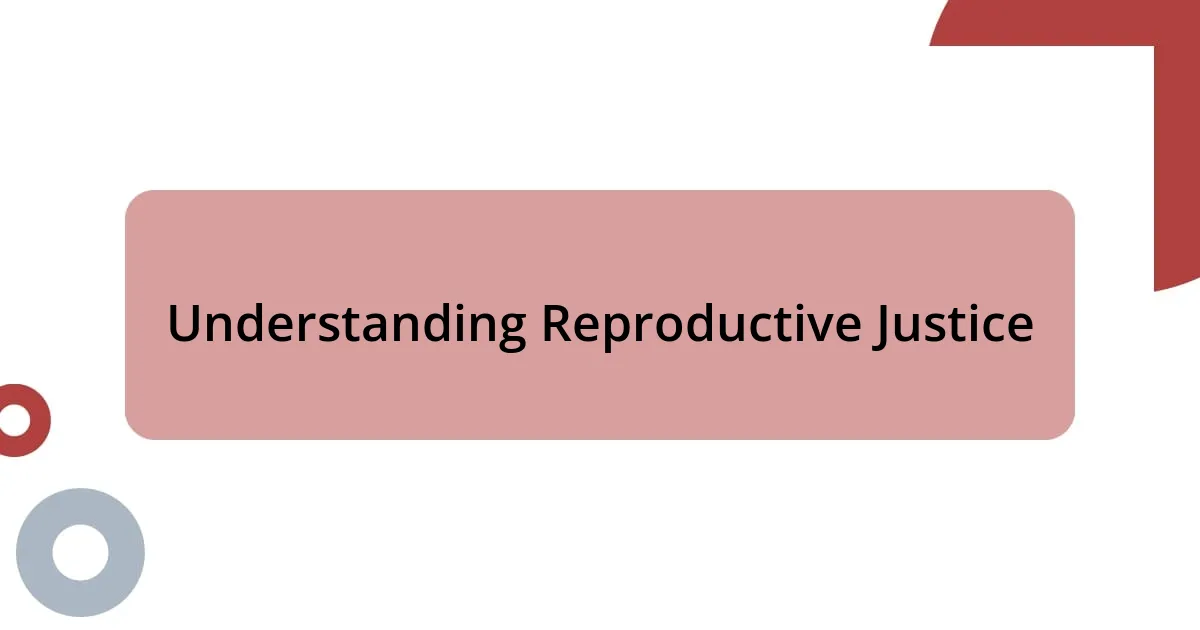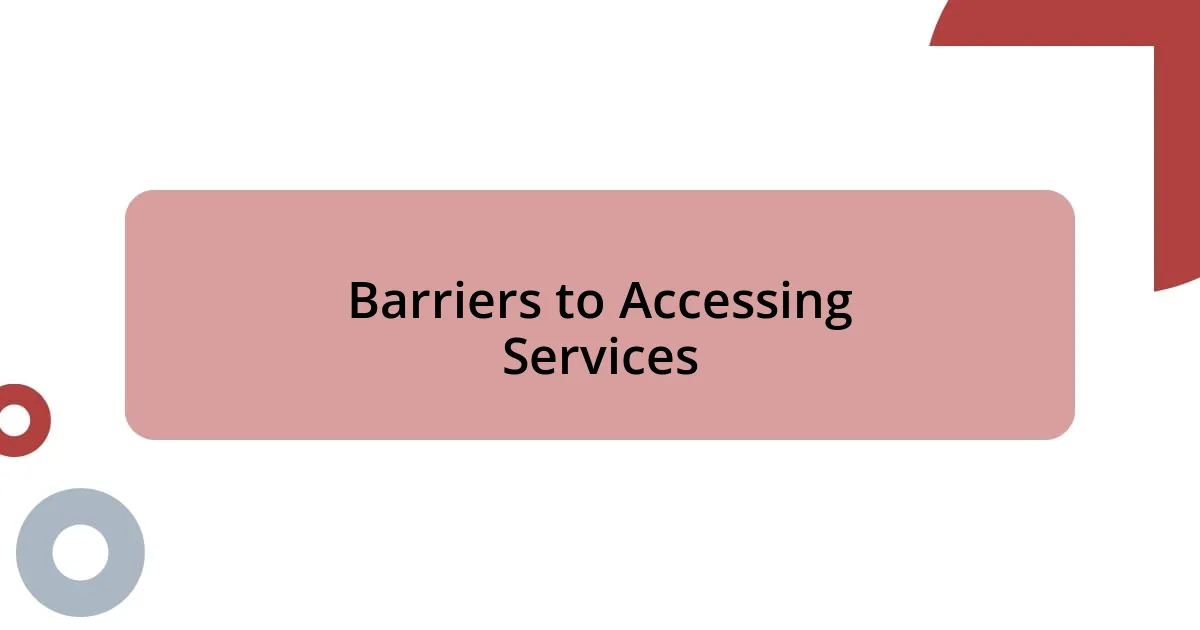Key takeaways:
- Reproductive justice encompasses not only the right to make choices regarding reproduction but also the necessary support systems, resources, and education to enact those choices, particularly for marginalized communities.
- Reproductive autonomy is essential for personal empowerment and societal progress; it serves as a crucial factor for individual well-being and reflects the commitment of communities to equity and justice.
- Barriers to accessing reproductive health services include financial constraints, geographical disparities, and cultural stigmas, which emphasize the need for systemic change and tailored solutions for different communities.
- Building coalitions, educating communities, and amplifying personal narratives are effective advocacy strategies for fostering empathy and driving meaningful change in the push for reproductive justice.

Understanding Reproductive Justice
Reproductive justice is more than just a stance on abortion or contraception; it encompasses a broader spectrum of rights related to reproduction and family planning. I remember a time when a close friend of mine faced an unplanned pregnancy and felt utterly lost. It made me realize that, for many, the choice surrounding pregnancy isn’t just about a decision—it’s about having access to healthcare, support systems, and education that empowers them to make informed choices.
When I delve into the core of reproductive justice, I can’t help but think about the intersectionality that shapes each individual’s experience. Take, for example, someone who identifies as low-income or a person of color; their barriers to reproductive healthcare can be daunting. I often wonder, how can we advocate for justice when many faces such systemic inequalities?
It’s crucial to understand that reproductive justice not only demands the right to make choices; it also insists that everyone has the necessary resources to enact those choices. I recall speaking with a young mother who shared her struggles to find affordable childcare while trying to pursue her education. Her story highlighted for me that true freedom in reproductive choices means having access to safe environments, education, and economic stability, reflecting the complexities that many face in their journey toward justice.

Importance of Reproductive Autonomy
Reproductive autonomy is vital because it directly influences the well-being and empowerment of individuals. I think of my friend Sarah, who, after navigating the complexities of her own reproductive decisions, emphasized how crucial it is for everyone to have the freedom to choose without fear or coercion. Her journey underscored to me that reproductive autonomy isn’t just a personal matter—it’s a fundamental right necessary for true self-determination.
Moreover, the importance of reproductive autonomy extends beyond individual choices; it serves as a social barometer reflecting broader societal values. I often reflect on a workshop I once attended, where participants shared how reclaiming their reproductive rights helped them gain a sense of control over their lives. It was inspiring to see how those empowering moments could ripple outwards, fostering stronger communities where people feel supported in their choices.
Ultimately, I believe reproductive autonomy is a building block for equity and health within society. When individuals possess the agency to make decisions about their own bodies, it contributes to greater community health and collective empowerment. I remember a powerful conversation I had with a group of activists who passionately argued that without reproductive autonomy, we hinder not only personal growth but societal progress as well. Their conviction resonated deeply with me, reinforcing the idea that reproductive justice is integral to our collective future.
| Aspect | Description |
|---|---|
| Personal Empowerment | Reproductive autonomy allows individuals to make informed choices about their own bodies. |
| Societal Reflection | Communities’ support for reproductive rights indicates their commitment to equity and justice. |
| Collective Progress | Empowering individuals in reproductive choices fosters stronger and healthier communities. |

Intersection of Health and Society
The way health intersects with societal structures is profoundly revealing. I think back to my time volunteering at a local clinic, where I met people from all walks of life. The stories they shared about their struggles with accessing crucial reproductive health services highlighted the systemic barriers many face. It became painfully clear that health disparities aren’t just numbers; they represent real lives hindered by societal inequalities.
- Access to healthcare often varies significantly based on socio-economic status, race, and geography.
- Many who seek reproductive health services face stigmas that affect their ability to receive care.
- Cultural narratives around reproductive health can lead to misinformation and fear, creating additional barriers.
In my experience, conversations about reproductive justice should always encompass these societal factors. I can still recall a heartfelt discussion with a community leader who shared how the lack of transportation options prevented many in her neighborhood from accessing healthcare facilities. Her frustration resonated with me. It made our conversations about health access not only a matter of policy, but also a matter of personal connection and community support.

Barriers to Accessing Services
Accessing reproductive health services can be like navigating a complex maze, riddled with obstacles that can feel overwhelming. I remember speaking with a young mother, Amanda, who shared her struggle to find affordable childcare while attending healthcare appointments. Her predicament made me question: how can we expect individuals to prioritize their reproductive health when basic support systems aren’t in place? It’s a stark reminder that barriers aren’t just logistical; they often reflect deeper societal issues.
Financial constraints are a major hurdle for many seeking reproductive services. During a workshop, I overheard a poignant conversation between two participants discussing how insurance coverage often falls short of covering essential reproductive health needs. The frustration in their voices struck me. It’s disheartening to think that so many people are forced to choose between their health and their financial stability—a choice no one should have to make.
Geographical access plays a significant role as well. I once had a friend who lived in a rural area where the nearest clinic was over an hour away. She often spoke about the mental toll it took on her just to plan a simple appointment. This brings to mind an important question: how do we create equitable access to services for those who are already marginalized? The answer likely lies in understanding that each person’s experience is unique, shaped by various factors, and addressing those layers is essential for achieving true reproductive justice.

Empowering Marginalized Communities
Working with marginalized communities has shown me just how crucial empowerment is for achieving reproductive justice. I once attended a community meeting where a group of women shared their stories, many of them echoing themes of silence and isolation. Their voices, full of passion and determination, resonated with me. It made me realize that empowerment isn’t just about access—it’s about creating spaces where these voices can flourish and lead the charge for change. How often do organizations truly listen to those they claim to serve? My experience tells me that genuine engagement can be a game-changer.
I remember a vibrant workshop we held, focusing on reproductive health education in a predominantly low-income neighborhood. The attendees were eager to learn about their rights and available resources, displaying a fierce commitment to equipping themselves and their community. What struck me the most was how many participants expressed gratitude for the opportunity to discuss their needs openly, something many had never experienced before. It made me think: why are these collective conversations so rare? I believe that nurturing leadership among marginalized voices is essential for dismantling the barriers they face.
In my view, supporting marginalized communities also means facilitating access to resources that empower their choices. I once met a group of teen advocates who organized their own campaign for sexual health education in their school. Their enthusiasm was infectious, and it highlighted how essential it is to invest in youth leadership. These young people often understand their community’s needs better than anyone else. Rather than imposing solutions, we should be asking: how can we create pathways for their leadership to shine? That approach not only uplifts individuals but invigorates entire communities, paving the way to true reproductive justice.

Advocacy Strategies for Change
Advocacy strategies for change hinge on building impactful coalitions. I recall a time when I collaborated with various local organizations to amplify a community-wide campaign for reproductive rights. Seeing how different perspectives converged was eye-opening; it underscored the importance of solidarity. Have you ever considered how powerful it can be when diverse groups unite for a shared cause? I believe that strength lies in numbers, and these alliances can bring about significant policy shifts.
Education is another critical component in advocacy. I once facilitated a workshop where participants explored local laws governing reproductive health. Their reactions were telling; many felt empowered to engage with lawmakers afterward, armed with knowledge. This experience made me wonder: what if every community had access to similar resources? By fostering an informed electorate, we not only enable individuals to advocate for themselves but also strengthen the movement as a whole.
Finally, grassroots storytelling is an invaluable tool for change. During a rally, I heard a woman share her deeply personal journey with reproductive health access. The vulnerability in her voice captivated everyone present and helped humanize the statistics we often discuss. I found myself asking: how can these stories shape public opinion? I truly believe that by putting real experiences front and center, we can inspire empathy and drive systemic change, making the fight for reproductive justice resonate on a deeper level.

Building a Supportive Community
Building a supportive community is essential for advancing reproductive justice. I remember a small gathering where individuals shared their varied journeys, creating a tapestry of experiences that highlighted the importance of connection. It was heartening to see how simply being in the same space allowed folks to find solace in shared struggles. Have you ever been part of a conversation that made you realize you weren’t alone? Moments like those can spark a transformative sense of belonging.
In one initiative I participated in, we organized monthly forums centered on fostering dialogue among community members. Each session encouraged participants to voice their concerns about reproductive health access freely. The emotional weight in the room was palpable, and I couldn’t help but think about how often these vital conversations are stifled. The more we create avenues for open discussion, the more empowered individuals feel to advocate for their rights and the rights of their peers. It’s this kind of nurturing environment that allows communities to thrive.
I also recall working with a local arts group that hosted a project centered on reproductive justice storytelling. The creativity unleashed was astounding; seeing people express their experiences through art made the topic more relatable and approachable. Don’t you think art can bridge gaps that traditional advocacy sometimes can’t? It reaffirmed my belief that building a supportive community goes beyond sharing information; it’s about fostering empathy and understanding through creative expression. Together, we can weave a stronger fabric of solidarity that uplifts everyone involved.














